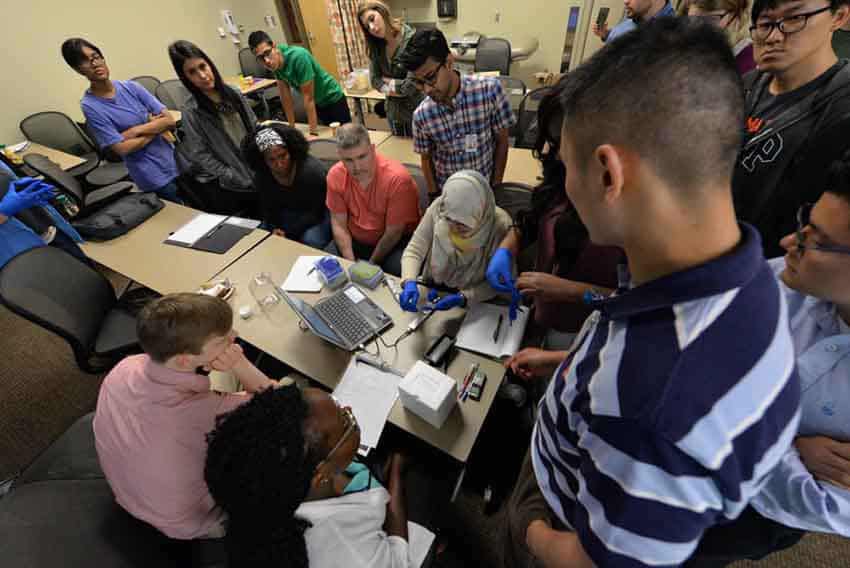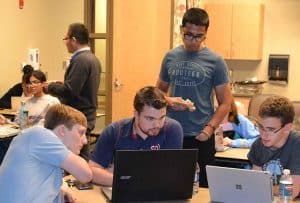Genomics Workshop Ignites Students’ Passion for Research
| March 31, 2017 | A two-day workshop at UAMS made undergraduate student Daniel Games eager to get to something most people want to avoid — viruses.
“I didn’t expect to get this much hands-on work,” Games said. “That was great. The workshop lectures were interesting, too, but today was all hands-on software work. We got to do everything they had talked about the first day, and that was pretty exciting. I can’t wait to go back to use what I’ve learned on viruses.”

On the second day of the Genomics Workshop, students analyze data from the genetic samples they had sequenced earlier.
Games, a Ouachita Baptist University junior, was one of about 30 who attended a genomics workshop March 20-21 presented by UAMS and the University of Arkansas at Little Rock (UALR). Games is a double major in biology and computer science, and his senior thesis is on the health impact of viruses.
The workshop was supported by the Arkansas IDeA Networks of Biomedical Research Excellence (INBRE). Arkansas INBRE is led by Lawrence Cornett, Ph.D., UAMS vice chancellor for research. Genomics is the study of all of the genetic material of an organism. Bioinformatics uses computational methods for the study of biological information that flows from the decoding and analysis of DNA, RNA and proteins. Genome sequences can be used in the first step of modeling complex biological systems.
Elizabeth Pierce, associate professor and chair of the UALR Department of Information Science, proposed the workshop and organized it along with David Ussery, Ph.D., director of the Arkansas Center for Ecological and Genomic Medicine at UAMS and professor in the UAMS College of Medicine Department of Biomedical Informatics. Ussery lectured during the workshop, recruited other lecturers and helped develop much of the curriculum.
“I wanted to attend the workshop because genomics is so revolutionary in the field of medicine right now,” said Leah Ward, who is studying biochemistry as a junior at the University of Arkansas at Fayetteville (UAF). “I’m planning on going to pharmacy school, which still is an option. There is so much more we can do in the clinical and therapeutic areas with genomics though.”
A UAF genetics course gave her a good education and overview regarding genetics theory and concepts, Ward said. Before the workshop, Ward wanted to see how those theories and concepts along with the innovations in genetics might be applied to her potential career path in pharmacy or even be a career path all its own.
Ward enjoyed the hands-on experience sequencing part of a genome and analyzing the results. Plus, it was a great chance to network with scientists and science-minded students.

David Ussery, Ph.D., lectures at the Genomics Workshop, giving attendees an overview and brief history of genomic science.
“We’ve had a lot of practical knowledge sessions,” Ward said. “This is along the lines of what I was expecting. One thing I’ve really enjoyed about this workshop is the diversity within the group. There are high school students, undergraduate students, people getting doctorates. It’s a wide array of people.”
One person attending the workshop, and also assisting where he could, was Kaleb Abram, a 2015 UAF graduate in biomedical engineering who recently started work as a UAMS lab support technician in the Department of Biomedical Informatics. He is a computer programmer.
Abram said software for the sequencing and analysis of genomes is designed to run on all systems and sometimes some extra coding or work with the software is needed to for a specific task.
“Everyone got a realistic taste of genomics, which is that nothing works perfectly,” Abram said. “I felt it helped a lot of the kids see the problems you can have. Even with issues, you’re still able to solve them and walk away with results.”
Students were divided into three groups of ten for the hands-on tasks. Each group was given a DNA sample to analyze, but were not told what it was. On the first day, the students inserted the sample in Oxford Nanopore flow cells (small ‘disposable’ third-generation sequencing machines that can be used a few times and then discarded). The handheld nanopore devices then were plugged into laptops, and the samples were sequenced. To identify the organism of their unknown DNA sample, the groups on the second day compared their sequences obtained from the nanopore to known genomes in a huge DNA database. The samples were of bacterial DNA, and for each student, their best match was to the same bacterial species as found from the other nine members in their group.
“I liked how enthusiastic everyone was,” Abram said. “It was exciting to see these college and high school kids genuinely having these passions. They’re not going through the motions.”
More than 80 applied to attend the workshop, Ussery said. He and Pierce deliberately selected a mix of high school students and undergraduate students as well as a handful of postdoctoral fellows and two professors.
“The purpose of the workshop is partly to spark interest in bioinformatics and genomics,” Ussery said. “Some people here are thinking about it in terms of graduate careers, but also to show off this new field and teach them what is going on.”
Pierce said reaching the undergraduate students and high school students was particularly important because they have several years ahead to explore and to prepare to go into the fields of genomics and bioinformatics if it sparks their interest.
“In informatics, you see all these specialties popping up and growing,” Pierce said. “I tell students they need to know this just like statistics. No matter what life science field you’re in, you’re going to use bioinformatics. I don’t want you to give up your passion for biology if that’s your field, but you should add these skills to your toolkit.”

